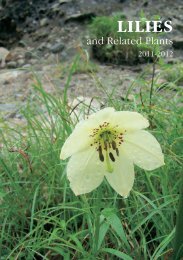LILIES - RHS Lily Group
LILIES - RHS Lily Group
LILIES - RHS Lily Group
You also want an ePaper? Increase the reach of your titles
YUMPU automatically turns print PDFs into web optimized ePapers that Google loves.
progeny. Although there was no debate about the identity of the L. pardalinum<br />
plants we found, or that some of the plants growing nearby were hybrids, Barb<br />
was not convinced that the pale orange lilies we also found were L. wigginsii, as<br />
she felt the flower of this lily should be yellow. However, the L. wigginsii I grow in<br />
my garden and photographs of this lily I have seen in reference books are almost<br />
identical in colour to the lilies growing beside Onion Lake. Unfortunately, I’m not<br />
yet in a position to compare my own naturally occurring hybrids, between my<br />
L. pardalinum and L. wigginsii, with the photographs I took of the Onion Lake<br />
hybrids, but this should be possible in a year or two when it will be interesting to<br />
see if the flower colours relate. As two parents are required to produce hybrids<br />
and Barb wasn’t convinced about the non-yellow L. wigginsii, she postulated that<br />
L. kelloggii might be the mystery paramour of L. pardalinum, but as all of the<br />
Onion Lake lilies were growing in a water meadow and L. kelloggii is a dry land<br />
lily I had to beg to differ with that suggestion. The next lily we encountered, after<br />
leaving the tranquil shores of Onion Lake, was L. bolanderi. This is a much sought<br />
after, dry land, lily that has very pretty outward facing campanulate flowers, which<br />
Derek Fox has described as vinous or brick red in colour. The glaucous sheen of<br />
the stem, leaves and flower buds further enhance this lovely lily.<br />
By the time we reached Eureka, on the Pacific coast, the hot sun had been<br />
replaced with a chilly low-lying wet mist that reminded me of Scotland. When<br />
we headed south to Table Bluff, the next day, the pleasure of seeing about a<br />
dozen flowering plants of L. occidentale was tempered by the dreich (damp and<br />
depressing) morning. I have always thought the Scots have the best words to<br />
describe unpleasant weather, dreich being one of the more evocative – I wonder<br />
why that is? L. occidentale, so named because it is the most westerly American<br />
species lily, is much prettier than its relative L. pardalinum. On the outside of<br />
the flower the tepals are recurved, narrowly delicate and deep crimson, while the<br />
inside of the flower contrasts the deep crimson with a yellowish centre decorated<br />
with maroon spotting. This is a very rare lily, which had some protection, from<br />
wire netting, but it is a moot point as to how effective this will be in denying<br />
the appetites of the deer we saw scampering off, as we approached the breach<br />
in the fence around the sanctuary perimeter. Fortunately, local conservation<br />
efforts are in place, at a plant nursery nearby in Kneeland, so the future for<br />
L. occidentale may be more hopeful than it at first appears. Apparently, this<br />
lily is not difficult to grow in the UK as Patrick Synge, in his book Lilies, refers<br />
to Dee Simmons and Oliver Wyatt as testifying. However, that was many years<br />
ago, so I think the opportunity to grow this lily currently could be far less likely.<br />
After we had visited the nursery at Kneeland we headed west until we found a<br />
number of plants of L. kelloggii flowering by the roadside. Although identified<br />
in reference books as a dry land lily, these plants were growing in a lushly<br />
75




